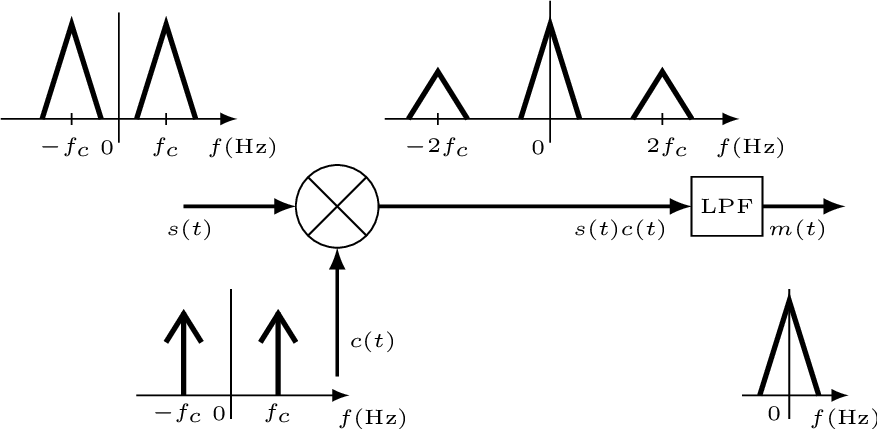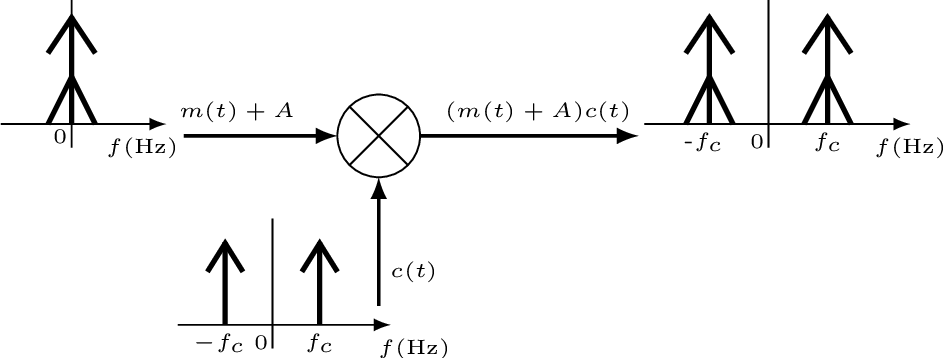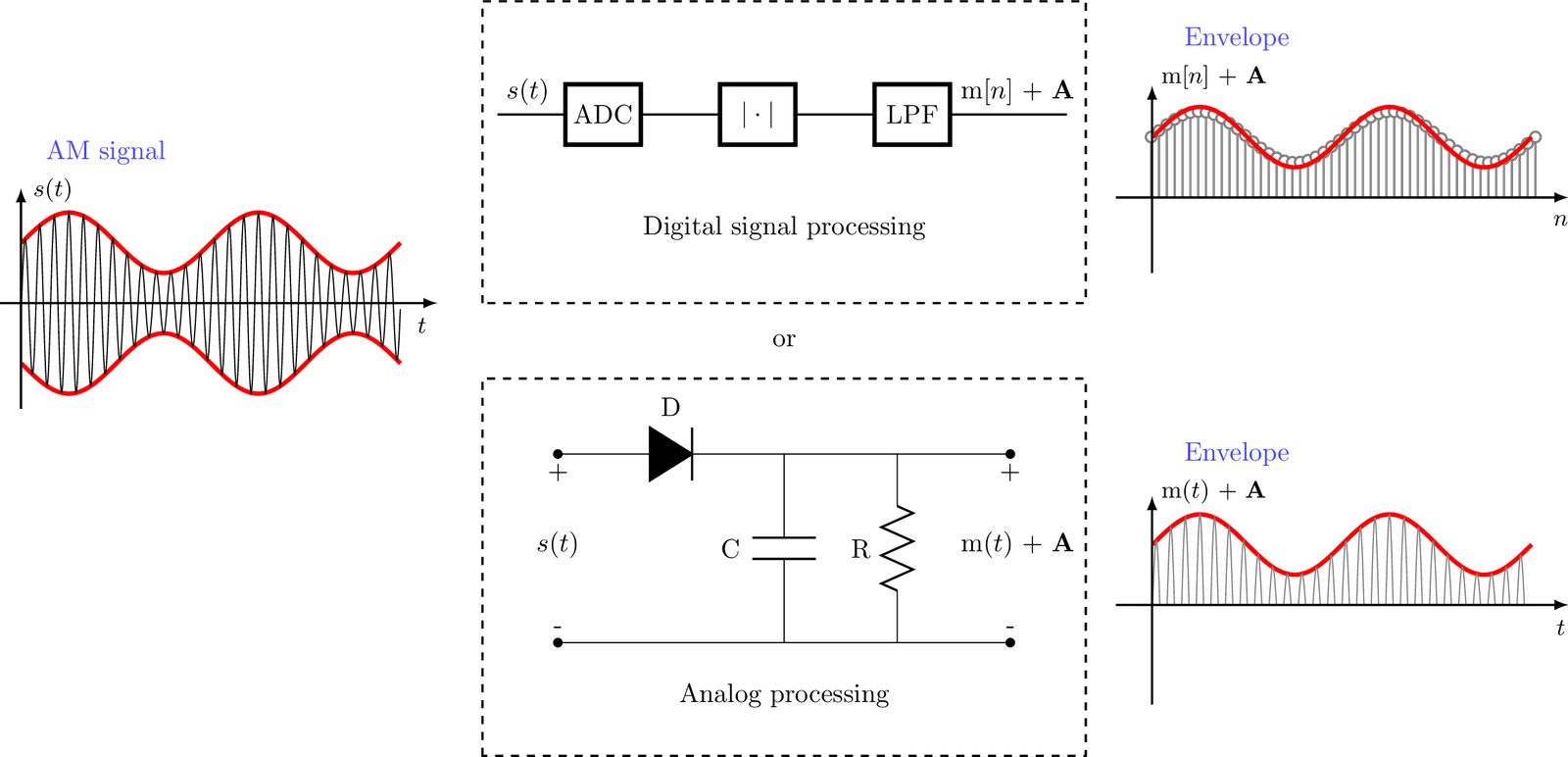1.3 Examples of Analog Amplitude Modulation
1.3.1 DSB-SC
Amplitude modulation can be performed by multiplying, via a mixer, the information signal (corresponding to in Figure 1.2) and a carrier to obtain the transmit signal
|
| (1.1) |
The modulating signal effectively changes the carrier amplitude over time. Consequently, the information of interest is “encoded” on the amplitude of .
Coherent or synchronous demodulation allows to recover from in Eq. (1.1). The term “coherent” is used because this demodulation scheme requires generating the carrier at the receiver by recovering both its frequency and phase . In practice, the receiver uses estimates and of the correct values and .
To simplify the discussion, assume the ideal case of having and , with perfectly regenerated at the receiver. In this case, can be recovered by lowpass filtering the product as follows:
which is illustrated in Figure 1.3.

This amplitude modulation scheme is called DSB-SC (double-sideband suppressed carrier) because the carrier “is not transmitted” and the bandwidth of is twice the bandwidth of the information signal.
In practice, several non-ideal circuits and algorithms impact the process suggested by Figure 1.3:
- The receiver may estimate the correct frequency as instead, with the estimate error being called frequency offset;
- Similarly, the phase estimate may incorporate a phase offset ;
- A nonideal lowpass filter will attenuate the replicas at but not completely eliminate them. Besides, the nonideal filter will eventually distort the amplitude and phase of its input signal.
The reader is invited to explore the individual effects of each impairment using simulations.
1.3.2 SSB and VSB
Besides DSB-SC, there are several amplitude modulation schemes for analog signals, such as SSB, VSB and AM, for example. The SSB (single-sideband) and VSB (vestigial-sideband) are amplitude modulation schemes that, when compared to DSB schemes, reduce the required bandwidth to a value . The main interest here is in AM, which is a DSB scheme () but, in contrast to DSB-SC, does not suppress the carrier. It is adopted by commercial broadcast stations and due to its popularity is simply called AM here.
1.3.3 AM
To enable envelope detection and, consequently, avoid coherent demodulation, AM is a modulation scheme in which a DC level is added to the information signal before multiplication by the sinusoid carrier . Different than the DSB-SC of Eq. (1.1), the AM transmit signal is
|
| (1.2) |
The amplitude is chosen to be not smaller than the magnitude of the negative peak of , with assumed to have mean such that is indeed negative. This way the transmitter guarantees that , which allows to be recovered by a relatively cheap envelope detection of the received version of . An AM receiver signal can recover in Eq. (1.2) using coherent demodulation, but the envelope detection scheme is simpler and cheaper to implement.
In designing an analog amplitude-modulation system, one must choose between a more energy-efficient DSB-SC scheme and a simpler AM scheme that allows envelope detection at the receiver but requires the transmitter to spend additional power transmitting the carrier.
Advanced: PSD of AM signals
Assuming is zero-mean and following the reasoning discussed in Section F.5.5, the AM signal of Eq. (1.2) has PSD given by
|
| (1.3) |
where is the PSD of .
Using Eq. (F.20) to integrate Eq. (1.3) over frequency shows that the parcel that “transmits the carrier” corresponds to an overhead that consumes power . This is consistent with the fact that this parcel in time-domain is and is the power of a cosine.
Figure 1.4 illustrates that the added DC level appears as an impulse in the PSD of , which is shifted to the frequencies by the mixer. It should be contrasted with the DSB-SC PSD at the right of Figure 1.2, which does not have the impulses corresponding to the DC level.

Example 1.2. Example of PSD mask for AM transmission. Figure 1.5 gives an example of a possible RF PSD mask for AM transmission2 with PSD values given in dBc, i. e., with respect to the carrier power. The mask in this example indicates that within 10.2 kHz from the channel frequency, the PSD cannot exceed dBc.

PSD masks are imposed by regulatory agencies and indicate the limits but, for example, many AM broadcasters use BW smaller than 10 kHz such as 5 kHz.
Conceptually, the AM signal can be demodulated with the schemes depicted in Figure 1.6 using either digital or analog signal processing.3 In practice, several extra processing stages must be added, as will be discussed in Section 1.4.

Example 1.3. The carrier frequency must be high enough. The signals in Figure 1.6 can be generated with Listing 1.1 (only the first lines are shown here).
1N=80; %total number of samples used in the simulation 2Np=8, Ns=50; %period of carrier and information signal, respectively 3Ts=0.25; %sampling period in seconds 4n=0:N-1; t=n*Ts; %abscissas in n and t, respectively 5m=sin(2*pi/Ns*n); %information signal 6A=1.8; %DC level 7x=(m+A).*cos(2*pi/Np*n); %AM signal
One should observe that the carrier frequency must be high enough to have the AM demodulation working properly. The reader is invited to change the period of the carrier frequency in Listing 1.1 from 2 to 16 samples, and observe the results.
Applications 1.1 and 1.2 further discuss AM.
Advanced: AM modulation index and power overhead
How large is the AM power overhead is controlled by the modulation index , which is a measure of how much the peak amplitude of in Eq. (1.2) varies with respect to the unmodulated amplitude (i. e., in Eq. (1.2)). With being zero-mean and having the same amplitude values for the positive and negative peaks (i. e., ), is given by
|
| (1.4) |
and often expressed as a percentage. To allow envelope detection, a modulation index not larger than 100% is required.4 The impact of in the AM power overhead is discussed in the sequel.
Example 1.4. AM power overhead when the information signal is a sinusoid. To simplify the analysis, assume that is a pure sinusoid with peak value and frequency . In this case, using Eq. (A.10), one can calculate that the parcel of Eq. (1.2) has power . Hence, the total power of the AM signal, in the case of being a sinusoid, is:
|
| (1.5) |
As mentioned, the maximum for envelope detection is 100% and, in this case, the AM power overhead is such that the signal parcel that carries information corresponds to only 33.3% of the transmit power. In practice, and the AM power overhead would be larger than for a sinusoidal .
Example 1.5. AM power overhead when the information signal has amplitude normally distributed. As another example, consider when the amplitude of is distributed according to a Gaussian with and variance (power) . After multiplication by the carrier cosine, , as discussed in Section F.5.5. To relate and , assume that the peak value of is , such that from Eq. (1.4), .
|
| (1.6) |
In this case, even would lead to and a 90% power overhead.
Many methods have been investigated to decrease the AM power overhead such as “companding”, which is similar to the strategy used in PCM with or A-law to compress (at Tx) and expand (at Rx) the amplitude of .